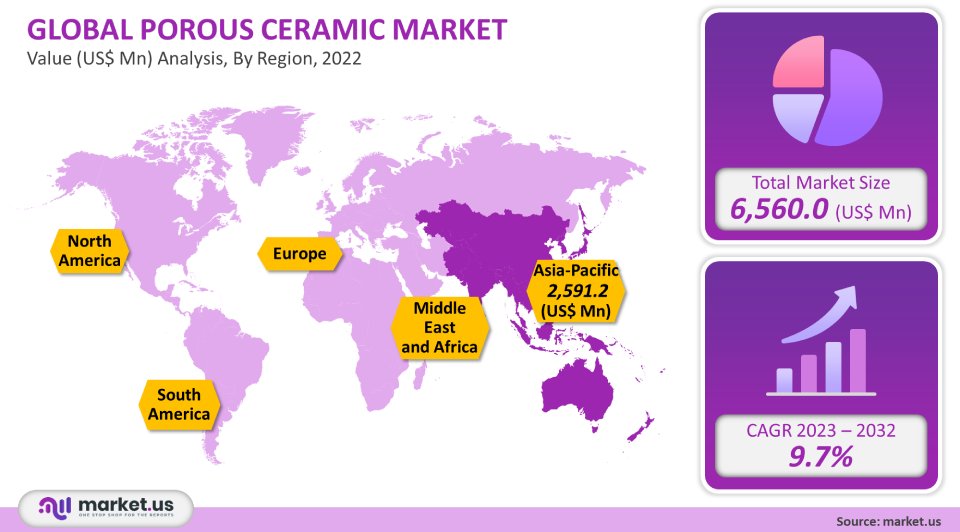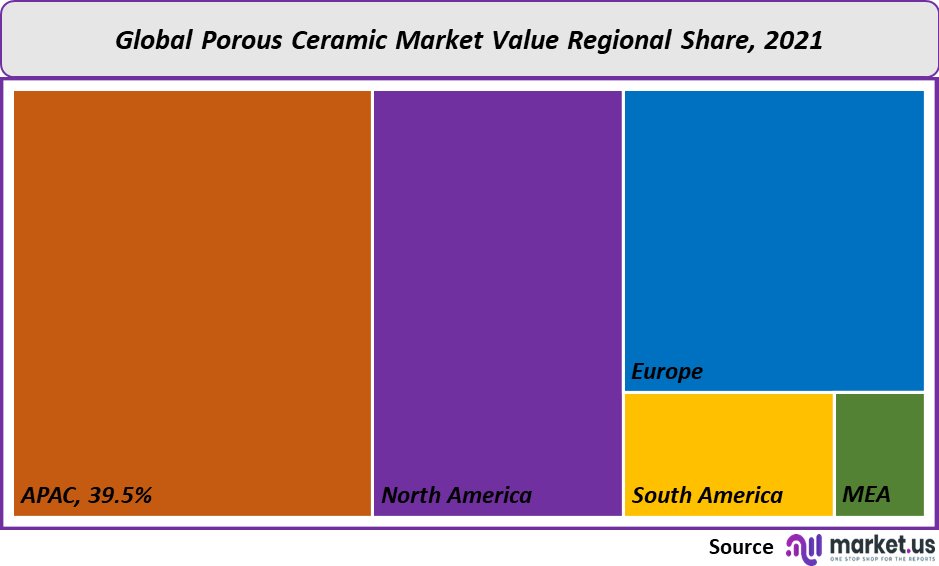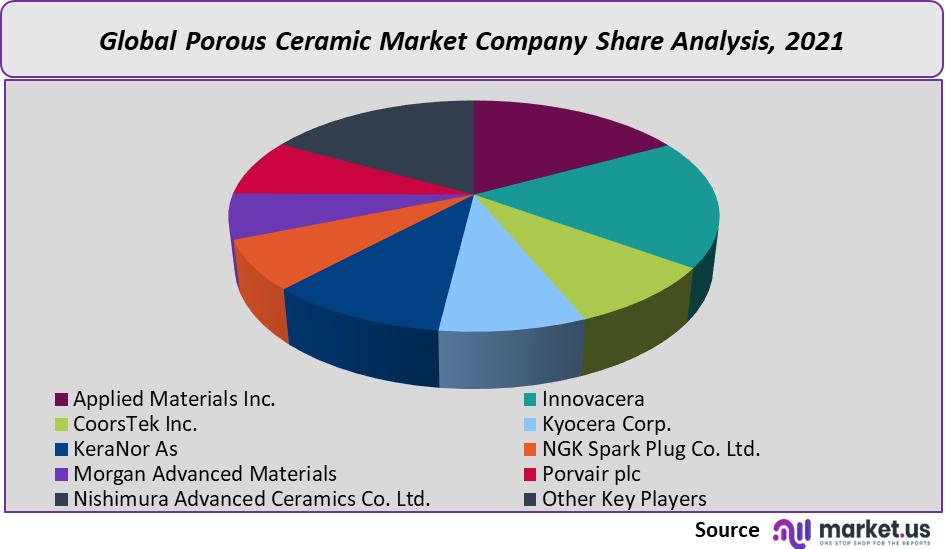Global Porous Ceramic Market By Product (Filtration, High Purity Materials, Insulation, and Others), By Raw Material (Titanate Ceramics, Alumina Ceramics, Ferrite Ceramics, Zirconate Ceramic, and Others), By Application (Medical, Automotive, Energy & Power, Electronics & Semiconductors, and Others), By Region and Companies - Industry Segment Outlook, Market Assessment, Competition Scenario, Trends and Forecast 2023-2032
- Published date: Feb 2022
- Report ID: 70768
- Number of Pages: 205
- Format:
- keyboard_arrow_up
Porous Ceramic Market Overview:
The global porous ceramic market was valued in 2021 at USD 6,560.0 million. This market is expected to grow at a 9.7% CAGR, between 2023-2032.
The market is growing due to the rising demand for filtration and the increasing penetration of medical devices, equipment, and products. Growing demand for high-quality, functional safety in medical equipment and devices to meet stringent approval standards has increased the need for reliable materials such as porous ceramics. Market growth is expected to be boosted by the widespread use of medical devices over the forecast period. The U.S. has been a significant producer and consumer of this market.
Global Porous Ceramic Market Scope:
Product Analysis
In 2021, the filtration segment accounted for 33.2% of total revenue. Porous ceramic-based filters filter particles from liquids and air under both extreme and normal pressure and temperature conditions. They are widely used in various industries like automotive, chemical, and pharmaceuticals as well as food. The future will see a rise in product demand due to the increasing need for filtration.
Over the projection period, insulation is expected to experience the second-fastest CAGR in terms of revenue. Due to improvements in ceramic production technology, highly porous ceramic foams are being employed more frequently in blast furnaces as thermal insulation. Refractories will become more and more in demand during the predicted period. High-purity material is expected to see the greatest CAGR during the forecast period. Because of their fine grain sizes, components made from high-purity materials have superior surface finishes. They offer many advantages over low-purity material, including excellent hardness and flexural strength as well as dielectric strength. They also provide high thermal shock resistance to components made of them.

Raw Material Analysis
Alumina raw materials accounted for the largest share of revenue at more than 42.4% in 2021. Alumina or aluminum dioxide has excellent electrical insulation and is being increasingly used as high-quality ceramic material. Additionally, alumina can withstand corrosion and wear making it highly suitable for electronic components such as pumps and automotive sensors.
Because of their exceptional properties, including low specific heat and bulk density, as well as their low thermal conductivity, alumina-based products have a high demand in the medical, semiconductor, and electrical industries. Market players are compelled to invest in R&D activities to develop new products due to the increasing demand. Its use in porous piezo ceramic pottery is expected to increase the market for titanium ceramics. It is also used as a dielectric in capacitors. It is used as a piezoelectric substance in microphones, transducers, and transducers. The pyroelectric, ferroelectric, and thermoelectric properties of barium titanium can also be used to make un-cooled sensors for thermal cameras.
Application Analysis
In 2021, automotive was the largest segment with a revenue share exceeding 30.2%. Porous ceramics are used extensively in automotive due to their outstanding properties. These include high mechanical strength, abrasion resistance, and chemical stability. Market growth is expected to be driven by investments in the automotive industry, specifically for the development of electric vehicles (EVs).
The market is also dominated by medical applications. Market growth is expected to be supported by the increasing adoption of additive manufacturing, which allows for the production of complex parts of medical devices. Skoltech Center for Design, Manufacturing, and Materials scientists developed an additive manufacturing method to create complex ceramic bone implant designs.The growing demand for capacitors, spark plugs, resistors, sensors, inductors, chips, and substrates. This is all due to the increased use of electronics & silicon in consumer appliances, television sets, smartphones, and computers. Technology advancements are expected to drive the electronics and semiconductors industry over the forecast period.
Key Market Segments:
By Product
- Filtration
- High Purity Materials
- Insulation
- Structural Components
- Others
By Raw Material
- Titanate Ceramics
- Alumina Ceramics
- Ferrite Ceramics
- Zirconate Ceramics
- Aluminum Nitride
- Others
By Application
- Medical
- Automotive
- Energy & Power
- Electronics & Semiconductors
- Aerospace & Defense
- Industrial
- Others
Market Dynamics:
High-purity porous ceramics have a wide variety of uses in microelectronics, including substrates, custom electronic parts, and piezoelectric devices. Market growth will be driven by increasing demand for electronic products and technological advancements in America over the forecast period.
The U.S. has an extensive network of semiconductor manufacturing clusters. A strong business & technological environment, a strict intellectual property rights system to protect patents and trademarks, as well as favorable programs are all factors that increase investments in the U.S. electronics and semiconductor industry and help drive market growth. The U.S. Department of Energy (DOE), for instance, announced in March 2021 a funding of US$ 54 million for microelectronics research that will power next-generation technology. According to DOE, the COVID-19 pandemic highlighted vulnerabilities in supply chains and the dearth of domestic semiconductor manufacturing. This investment will be a boost to semiconductor manufacturing and positive impact on the market growth during the forecast period.
High product costs are limiting the upward growth trend. High material and processing costs combined with large initial investments make manufacturing expensive. Rising prices of alumina are limiting their use and affecting the market growth. The porous ceramic market is expected to grow due to the increasing demand for filtration products across all industries, such as manufacturing and automotive. Demand will be further boosted by the increasing use of porous clay in medical devices and equipment.
Ceramics have seen an increase in demand because of the need for high-quality medical equipment. Also, ceramics must adhere to strict standards of approval. They are highly preferred in the medical sector due to their adaptability and customizability based on application requirements.
Additionally, the COVID-19 pandemic boosted the demand for porous ceramics. Saint-Gobain Performance Ceramics & Refractories has developed the Crystar high-porosity ceramic filter technology. It balances retention efficiency with air permeability. In order to stop the spread of COVID-19, Pracartis and Bouverat-Pernat worked together to develop the highly effective face mask known as Precimask.
Porous ceramic filters are also used in the separation of materials in the pharmaceutical, chemical, and food industries. These products are also used to create gas separation membranes because of their high permeability and reliability, durability, and resistance to high pressure.Manufacturers of porous ceramic filter goods have been forced to create new items due to the increasing demand. CeramTec introduced porous ceramic membranes for crossflow membrane filtration in August 2021. These multi-channel tubes, made of alumina, can be used in micro and ultrafiltration as well as Nano filtration in many industries such as pharmaceuticals and biotechnology.
But porous ceramic products can also be manufactured using technologies like partial sintering or sacrificial fugitives, replica templates, direct foaming, or other methods. Additive manufacturing and paste extrusion are used in the product manufacturing process. The high production cost can be attributed to both high CAPEX as well as high raw material costs. This will likely limit market growth during the forecast period.
Regional Analysis:
North America is forecast to see an 8.7% growth in revenue during the forecast period. Many government initiatives are expected to play an important role in driving North American demand for ceramic filters. Nanotechnology, which is being used in the filtration process, will allow for traction to fine ceramics and thus increase the market growth in North America over the forecast period.
U.S. government regulations, including the Clean Air Act (CAA), direct the EPA’s establishment of National Ambient Air Quality Standards. These standards will regulate the emission of toxic substances across industries. Ceramic filters are used more frequently to eliminate volatile organic compounds and gaseous emissions from industrial facilities. The U.S. government enforces various regulations, including CAA, that protect the public against exposure to harmful toxic gases. These regulations are expected to increase the demand for filters, which will positively influence the growth of the porous ceramic market.
The Asia Pacific dominated porous ceramic markets and was responsible for the largest revenue share, 39.5%, in 2021. This region will continue to dominate the market over the forecast period. The rapid industrialization of porous ceramics as filtration materials can be attributed in part to the strict enforcement of environmental regulations by the governments of various countries.China’s stringent laws are expected to support the growth of the porous ceramic market. China is also expected to benefit from water and air filters thanks to strict regulations regarding excessive industrial pollution. This is expected to increase the demand for porous ceramics in the coming years.

Key Regions and Countries covered іn thе rероrt:
- North America
- US
- Canada
- Mexico
- Europe
- Germany
- UK
- France
- Italy
- Russia
- Spain
- Rest of Europe
- APAC
- China
- Japan
- South Korea
- India
- Rest of Asia-Pacific
- South America
- Brazil
- Argentina
- Rest of South America
- MEA
- GCC
- South Africa
- Israel
- Rest of MEA
Market Share Analysis:
Global markets are characterized by strong competition due to prominent manufacturers serving major geopolitical regions around the world. These well-known manufacturers compete on price and product quality to increase product application in various industries such as healthcare, oil & Gas, aerospace, and mining. Products with excellent durability and extended life expectancy have been made possible by technical improvements and improvements to the production process. Selee Corp. and Kyocera Corp. are increasing their investments in mergers & Acquisitions to maintain a stronghold in the market by offering superior ceramic products at low prices. Kyocera Corp., for example, announced in May 2019 that it had purchased the advanced ceramics operations of Friatec GmbH from Kyocera Fineceramics GmbH. Kyocera Corp. is expected to benefit from the acquisition to deliver better services to its customers via local production and sales.

Key Market Players:
These are some of the major players in the global porous ceramic market:
- Applied Materials Inc.
- Innovacera
- CoorsTek Inc.
- Kyocera Corp.
- KeraNor As
- NGK Spark Plug Co. Ltd.
- Morgan Advanced Materials
- Porvair plc
- Nishimura Advanced Ceramics Co. Ltd.
- Other Key Players
For the Porous Ceramic Market research study, the following years have been considered to estimate the market size:
Attribute Report Details Historical Years
2016-2020
Base Year
2021
Estimated Year
2022
Short Term Projection Year
2028
Projected Year
2023
Long Term Projection Year
2032
Report Coverage
Competitive Landscape, Revenue analysis, Company Share Analysis, Manufacturers Analysis, Volume by Manufacturers, Key Segments, Key company analysis, Market Trends, Distribution Channel, Market Dynamics, COVID-19 Impact Analysis, strategy for existing players to grab maximum market share, and more.
Regional Scope
North America, Europe, Asia-Pacific, South America, Middle East & Africa
Country Scope
United States, Canada and Mexico, Germany, France, UK, Russia and Italy, China, Japan, Korea, India and Southeast Asia, Brazil, Argentina, Colombia etc.Saudi Arabia, UAE, Egypt, Nigeria and South Africa
Frequently Asked Questions (FAQ)
Q: What is the size of the Porous Ceramic market in 2021?The Porous Ceramic market size was US$ 6,560.0 million in 2021.
Q: What is the projected CAGR at which the Porous Ceramic market is expected to grow at?The Porous Ceramic market is expected to grow at a CAGR of 9.7% (2023-2032).
Q: List the segments encompassed in this report on the Porous Ceramic market?Market.US has segmented the Porous Ceramic market by geographic (North America, Europe, APAC, South America, and Middle East and Africa). By Product, market has been segmented into Filtration, High Purity Materials, Insulation, Structural Components, and Others. By Raw Material, the market has been further divided into Titanate Ceramics, Alumina Ceramics, Ferrite Ceramics, Zirconate Ceramics, Aluminum Nitride, and Others. By Application, market has been segmented into Medical, Automotive, Energy & Power, Electronics & Semiconductors, Aerospace & Defense, Industrial, and Others.
Q: List the key industry players of the Porous Ceramic market?Applied Materials Inc., Innovacera, CoorsTek Inc., Kyocera Corp., KeraNor As, NGK Spark Plug Co. Ltd., Morgan Advanced Materials, Porvair plc, Nishimura Advanced Ceramics Co. Ltd., and Other Key Players engaged in the Porous Ceramic market.
Q: Which region is more appealing for vendors employed in the Porous Ceramic market?Asia Pacific is accounted for the highest revenue share of 39.5%. Therefore, the Porous Ceramic industry in Asia Pacific is expected to garner significant business opportunities over the forecast period.
Q: Name the key areas of business for Porous Ceramic?France, Italy, Spain, China, India, Japan, Brazil, Etc. are key areas of operation for Porous Ceramic Market.
Q: Which segment accounts for the greatest market share in the Porous Ceramic industry?With respect to the Porous Ceramic industry, vendors can expect to leverage greater prospective business opportunities through the filtration segment, as this area of interest accounts for the largest market share.
![Porous Ceramic Market Porous Ceramic Market]()
- Applied Materials Inc.
- Innovacera
- CoorsTek Inc.
- Kyocera Corp.
- KeraNor As
- NGK Spark Plug Co. Ltd.
- Morgan Advanced Materials
- Porvair plc
- Nishimura Advanced Ceramics Co. Ltd.
- Other Key Players
- settingsSettings
Our Clients
|
Single User
$5,999
$2,999
USD / per unit
save 50% |
Multi User
$7,999
$3,499
USD / per unit
save 55% |
Corporate User
$12,999
$4,499
USD / per unit
save 65% | |
|---|---|---|---|
| e-Access | |||
| Data Set (Excel) | |||
| Company Profile Library Access | |||
| Interactive Dashboard | |||
| Free Custumization | No | up to 10 hrs work | up to 30 hrs work |
| Accessibility | 1 User | 2-5 User | Unlimited |
| Analyst Support | up to 20 hrs | up to 40 hrs | up to 50 hrs |
| Benefit | Up to 20% off on next purchase | Up to 25% off on next purchase | Up to 30% off on next purchase |
| Buy Now ($ 2,999) | Buy Now ($ 3,499) | Buy Now ($ 4,499) |









